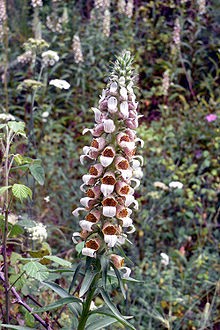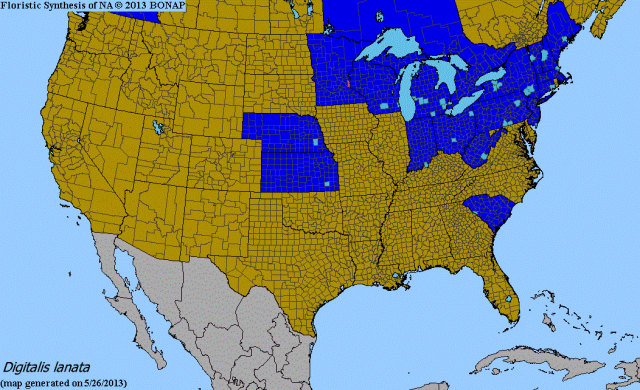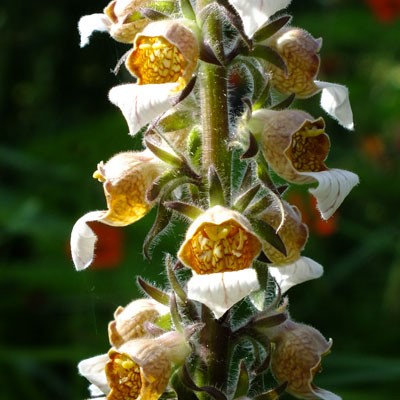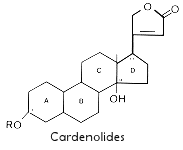Woolly Foxglove (Digitalis lanata)

General Plant Information:

Dark blue: Present, exotic Brown: Not present
Woolly Foxglove is a biennial plant (meaning it grows for two years) native to Europe, but has made its way to the New World, where it can be found in the Northeastern and Midwestern part of the United States and parts of Canada. Globally it is mostly found in Eastern Europe. Woolly foxglove is considered an invasive species in Minnesota and has been restricted to mainly Washington County.
The plant blooms between June-July and will grow between 1 to 4 feet in height. It grows best in part shade, part sun on woodland edges and open fields.
 The plant is identifiable by its elongated leaves, typically oval or oval that is tapered to a point, that are mid-green, woolly, veined (approximately 3-5 veins parallel veins, attachment is alternate) and on the leave’s bottoms are white hairs.
The plant is identifiable by its elongated leaves, typically oval or oval that is tapered to a point, that are mid-green, woolly, veined (approximately 3-5 veins parallel veins, attachment is alternate) and on the leave’s bottoms are white hairs.
The flowers look like white hanging bells with brown netting and a yellow inside, although some say they look more like gaping mouths. The flowers, like the leaves are also woolly/hairy and grow in a spike pattern. The plant typically blooms in its second year of growth.
The fruit is a pod covered with hooks that allow them to hook onto animals to be spread.
Traditional Uses:
Foxglove is incredibly toxic to humans if not taken at the right dosage. Despite the toxicity, the plant was used to treat a variety of ailments, like nasal congestion, sore throat, and as a compress for swelling and bruises since the 13th century. It can also be applied as an ointment for cleansing of old sores and ulcers. Foxglove leaves were historically used is England and other parts of Europe, like France, by grinding them and applying them as an ointment or ingesting them.
In England, it was used throughout the centuries, by collecting leaves and grounding them into a powder to treat dropsy (edema), due to heart failure. It is not known when foxglove first began being used to treat dropsy before English physician, William Withering published a paper on the herb in 1785. His paper discussed the 158 patients whom he had treated with foxglove, a total of 101 of these patients had congestive heart failure and experienced relief following the foxglove treatment. 57 of the patients who had pulmonary tuberculosis, which is not curable with foxglove, did not experience any relief. William Withering’s paper popularized the prescription of the plant, but he warned against generalizing on the basis of his cases, aware of the factors that might be affecting his results. Withering is also responsible for deriving the optimum quantity of the drug to be administered in a single dose. His work helped reduce the incidence of side effects, especially in his own practice as he gained more experience. Unfortunately, physicians often continued prescribing the incorrect dosage, which caused nausea, visual impairment, vomiting, and fainting.
The Chemistry of Woolly Foxglove:
 Approximately a century later in 1875, the chemical compound, digitoxin, was identified in foxglove and then isolated from foxglove in 1930. Beyond digitoxin, there are a number of cardioactive glycosides in foxglove, and currently has become a crucial drug in the treatment of coronary heart disease. The cardioactive glycosides in foxglove includes digitotoxin, digitalin, digoxin, and cardenolides: lanataglucosides A, B, C, D, and E that are all classified according to their chemical composition of their aglycones. Cardenolides are C23 steroids that effect the heart and kidney. When ingested they have a strong, bitter, and disagreeable taste.
Approximately a century later in 1875, the chemical compound, digitoxin, was identified in foxglove and then isolated from foxglove in 1930. Beyond digitoxin, there are a number of cardioactive glycosides in foxglove, and currently has become a crucial drug in the treatment of coronary heart disease. The cardioactive glycosides in foxglove includes digitotoxin, digitalin, digoxin, and cardenolides: lanataglucosides A, B, C, D, and E that are all classified according to their chemical composition of their aglycones. Cardenolides are C23 steroids that effect the heart and kidney. When ingested they have a strong, bitter, and disagreeable taste.
Current Medicinal Uses:
Currently, despite the controversy surrounding digoxin as a treatment method, the drug is still commonly used today in patients for whom other medical treatments are ineffective. Digoxin is still derived from the foxglove plant and not synthesized in factories.
Digitonin is still used in modern medicine to increase the force of the systolic contractions and increase the duration of the diastolic phase in congestive heart failure.
Digitoxin is now rarely used in current Western medical practice.
Digitalis has been largely replaced as a heart medicine by standardized pharmaceutical preparations (synthetic drugs), but the plant is still occasionally used as an ingredient in a class of heart drugs.
Current Research:
Recent studies have focused on the traditional usages of the drug and its impact on the human heart and the plant’s toxicity.
One interesting study looked at how woolly foxglove’s pharmacological compounds will respond to predicted changes in CO2 and temperature. The study found that the plant produced more digoxins at higher concentrations of carbon dioxide (Ziska et al., 2009). This could be concerning, if it is being used without medical assistance since the plant is already considered toxic. For more information on this study visit: https://www.ncbi.nlm.nih.gov/pmc/articles/PMC2649213/
Another study examined how individuals treated for heart disease with digitalis isolated from foxglove may have an increased risk of breast cancer. However, the systematic review of available epidemiological studies came back inconclusive. For more information on this study and how it was performed visit: https://www.ncbi.nlm.nih.gov/pubmed/28130772
A study on the plant’s role in heart ailments and cancer management was also conducted, particularly examining how foxglove can be used incorrectly, as accidental poisoning and mortalities have been observed. The study examines the different functions of cardiac glycosides, in hopes of creating better drugs. For more information on this study visit: https://www.ncbi.nlm.nih.gov/pubmed/28130772
Sources:
https://www.minnesotawildflowers.info/flower/grecian-foxglove
https://www.revolvy.com/main/index.php?s=Digitalis%20lanata&item_type=topic
https://dorsetperennials.co.uk/posts/perennials/digitalis-foxgloves-compared/
https://herbs-herbal-supplements.knoji.com/herbs-foxgloves-history-and-medicinal-uses/
http://botanical.com/botanical/mgmh/f/foxglo30.html
https://www.ncbi.nlm.nih.gov/pmc/articles/PMC2649213/
http://www.historyofscience.com/articles/jmnorman-william-withering.php
http://poisonousplants.ansci.cornell.edu/toxicagents/cardiacglyco.html
http://www.acphospitalist.org/archives/2010/03/newman.htm
https://pubs.acs.org/cen/coverstory/83/8325/8325digoxin.html
http://www.encyclopedia.com/plants-and-animals/plants/plants/foxglove
Page created by Carly Johnson
